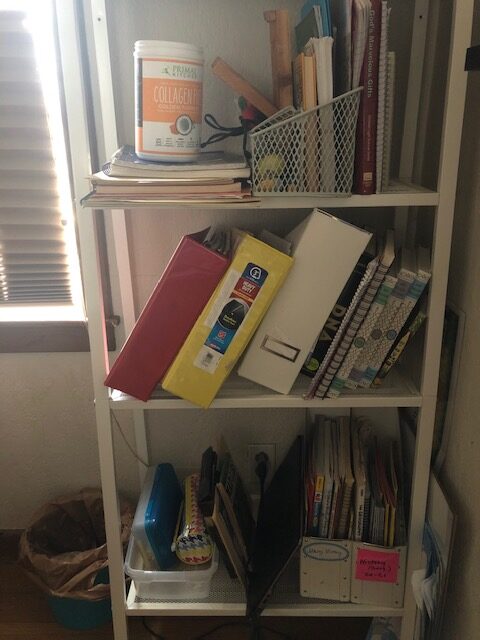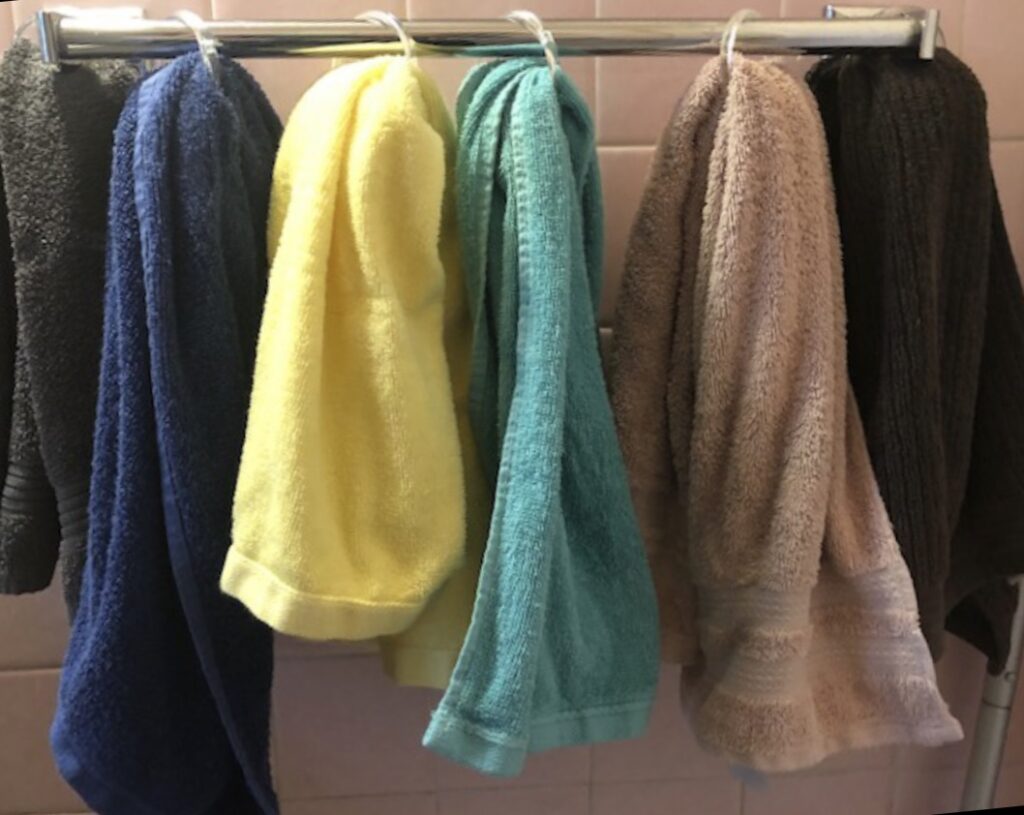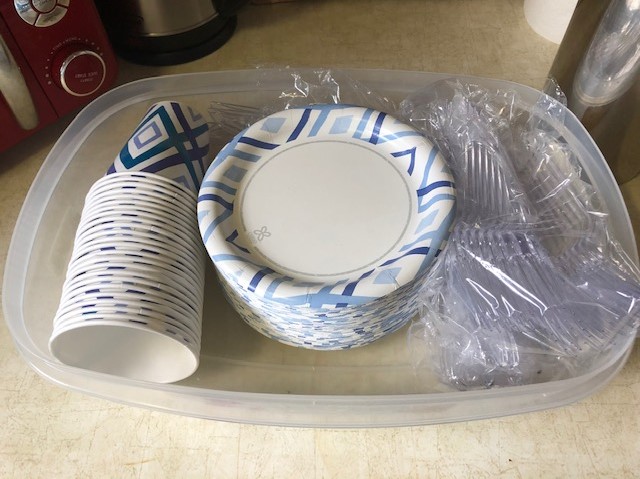Whether you’ve been doing this homeschool thing for a while now, like me, or you’re a complete newbie, there are always things we can learn from each other to be more efficient.
Sometimes the most basic things can fall through the cracks or we get out of the habit of doing something really helpful and wonder why we ever stopped! Been there? Me too!
So let’s get into these 5 tips to help boost your efficiency!
#1 Get your resources together in one place

Yep, it’s messy! But it works. This is our shelf of textbooks, notebooks, binders, markers, CDs, science kits, etc. Everything we need is in one central location. (I do have a huge resource room upstairs we can pull from since I have 15 years of curriculum!)
- Pull supplies no longer currently being used and purge or store.
- Keep a box in the closet to quickly fill with supplies being donated.
- Keep another box to fill with projects/papers being saved, labeled with the current school year. You can’t save it all so get picky.
- Train children to retrieve their supplies daily and put them back when they are done.
- Storage options could include free-standing or wall-mounted shelving, cubbies, a rolling desk cart, an old chest of drawers, an old file cabinet, a side table with bookends, or even concrete blocks with wood planks between them as shelves.
- I firmly believe we should shop our own home before we spend money on something new. I bet you can repurpose something you already own and have a great system! Walkthrough your home with new eyes looking for creative ways to use the things you already own.
#2 Have a plan

This is my “Mom” notebook.
You can see it has lots of great things tucked inside, including my yearly calendar defining our homeschooling weeks and vacation weeks, as well as tabs for things I need to access for different subjects including tables of contents, reading charts, answer keys, maps, notes for each child on things we are working on or need to explore, printables that get reused often and much more.
- Calendarpedia – Your source for calendars is a great website to print calendars and plan your year!
- Figure out how many weeks you want to homeschool (34-36 is pretty standard). Look at when you want to start and end the year and how many weeks of family vacation you will have. This is the framework you need to begin planning when you start, end, and when each vacation is.
- I know curriculum is so overwhelming (that’s a whole blog post in itself)! But for this blog, pick something and get started or you will spend lots of time agonizing over the nuances of each curriculum choice and you may not have the information you need to determine if it is a great fit for your kiddos until you begin.
- (Do some internet surfing, check Amazon reviews, and best of all, ask the homeschool moms you know. If you can join a homeschool mom group on Facebook you will find lots of recommendations from those of us in the trenches.)
- There are lots of free resources that are terrific too (another great blog post on its own) but I will share just one here that is super for kids up to about high school~ Welcome to Enchanted Learning! love these guys!
- You will never get to a point where it is “all figured out”…revision has continued for me since I started homeschooling 15 years ago so expect that and embrace it. Perfection isn’t the goal, but always striving to improve and move forward.
- Your mom notebook will always be a work in progress, and that’s a good thing because it shows you are adapting to an ever-changing environment.
#3 Start every day with Bible time

Do not conform to the pattern of this world, but be transformed by the renewing of your mind. Then you will be able to test and approve what God’s will is—his good, pleasing and perfect will.
We have prioritized this because we want to renew our minds through the word of God before we begin any other subjects.
This focuses our lens so we can see an eternal and Godly perspective as we move through the subjects.
It lightens the load and encourages the heart to start each day in scripture and gives God his correct place as the priority in our homeschooling journey.
- A simple spiral notebook works terrific to take praises and prayer requests.
- Ask each child for a few praises and prayer requests and jot them in your prayer spiral, alternating who goes first each day. They quickly begin to grasp how this works and look forward to sharing. Encourage ones who are timid by helping them think of one thing they are thankful for.
- I pray and include all the things shared. Eventually, older students may enjoy offering the prayer.
- Stick with it! If you are new to this persevere and you will see your children learning an important life lesson modeled in your homeschooling: how to take inventory of all that God has done and how to go to him in prayer and worship daily.
- After our prayer time, we work on bible work together. This could be a devotional, keyword study, topical study, SOAP journal (Scripture, Observation, Application, Prayer), teaching from a book…the options are endless! Right now we are using a book by Ken Ham called The Lie- Evolution. Again, just get started. Open your bible and work on memorizing a foundational verse like John 3:16, and the Lord will direct where he wants you!
#4 Keep the bathroom efficient

Let’s face it if you homeschool there is lots of traffic in the bathroom, and that creates work. Homeschooling doesn’t exist in a vacuum and is intimately tied to what’s happening in the home, so those systems are important too!
I dislike very much using a damp handtowel- yuck! We switched to stacks of white washcloths that were used once and thrown in a basket to be laundered; this created lots and lots of extra laundry!
- Switch to personal handtowels, color-coded for each member of the family.
- Small children (and boys!) who are learning to wash may be transferring germs to the handtowel unknowingly. This helps keep everyone healthy.
- Add changing the towel to any weekly chore lists for each child.
#5 Keep the kitchen efficient
Here’s another small tip that can have big results! Use paper products strategically.
No one loves dishes more than me (I may have a slight problem), they are beautiful and bring my heart joy every time I use them. I even enjoy washing and handling them, but when dishes are piling up in the sink (maybe the dishwasher is clean…) and everyone is focused on their next project, stopping to handle kitchen issues is a real efficiency killer.
- Consider using disposable products during the school day to keep things moving and kitchen build-up to a minimum.
- I use the bin in the photo above each evening. When I am done cleaning the kitchen and doing dishes for the day (yes, my kids help too) I set this bin on the counter. That is the cue that no more dishes should be created for the day because mom is tired and wants a clean kitchen in the morning!
- If you have a good system in place for dishes, use your disposables on days or times when things are out of order and help is needed.
- Waking up to an empty sink is a true kitchen goal! It feels so good to start the day without yesterday’s work staring at you, and you deserve it, my friend!
- Yes, I care about the environment. But I also care about my sanity. Using disposables responsibly does not mean you are lazy or don’t care about reducing waste. It means you are in a season of life where you need help. And that’s OK.

